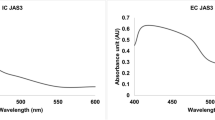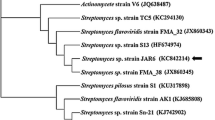Abstract
Prodigiosin is a red pigment commonly produced as a secondary metabolite by Serratia marcescens. It exhibits inherent bioactivities, including antimicrobial and anticancer, with low to no toxic effects on normal cells. The present study investigates a bioactive prodigiosin production from an atypical, red-pigmented, potentially novel Janthinobacterium sp. ERMR3:09 isolated from a glacial moraine. Statistically optimized culture parameters, i.e., w/v 1.0% glucose and 0.08% peptone as carbon and nitrogen sources, temperature 20 °C, and media pH 7, resulted in a four-fold increase in the pigment yield. The upscaled production in an 8 L volume resulted in higher pigment production within a shorter period of 48 h. The ultra-performance liquid chromatography (UPLC) analysis validated the identity of the purified pigment as prodigiosin that showed thermostability at 75 °C for 3 h. Evaluation of antimicrobial activity showed potent inhibitory effects (> 50%) against the opportunistic pathogenic fungal and Gram-positive bacterial strains. The pigment showed significant cytotoxicity (p < 0.05) towards A549 and HeLa cell lines with IC50 values of 42.2 μM and 36.11 μM, respectively. The study demonstrated that microbial communities from extreme niches can be ideal sources of bioactive pigments with immense pharmaceutical potential vital for the development of non-synthetic therapeutic agents.






Similar content being viewed by others
Data availability
The 16S rRNA gene sequence and complete genome sequence of ERMR3:09 are deposited in GenBank under the accession numbers MT355525 and CP075583, respectively. The strain is deposited in the Microbial Culture Collection at National Centre for Cell Science, Pune, India, under the accession number MCC 4783.
References
Afra S, Makhdoumi A, Matin MM, Feizy J (2017) A novel red pigment from marine Arthrobacter sp. G20 with specific anticancer activity. J Appl Microbiol 123(5):1228–1236
Anwar MM, Albanese C, Hamdy NM, Sultan AS (2022) Rise of the natural red pigment ‘prodigiosin’ as an immunomodulator in cancer. Cancer Cell Int 22(1):419
Balasubramaniam B, Alexpandi R, Darjily DR (2019) Exploration of the optimized parameters for bioactive prodigiosin mass production and its biomedical applications in vitro as well as in silico. Biocatal Agric Biotechnol 22:101385
Bhagwat A, Padalia U (2020) Optimization of prodigiosin biosynthesis by Serratia marcescens using unconventional bioresources. J Genet Eng Biotechnol 18(1):1–9
Bisht G, Srivastava S, Kulshreshtha R, Sourirajan A, Baumler DJ, Dev K (2020) Applications of red pigments from psychrophilic Rhodonellum psychrophilum GL8 in health, food and antimicrobial finishes on textiles. Process Biochem 94:15–29
Brehl C, Brass HUC, Lüchtrath C, Böckmann L, Ihling N, Classen T, Büchs J et al (2022) Optimized prodigiosin production with Pseudomonas putida KT2440 using parallelized noninvasive online monitoring. Biotechnol Prog 38:e3245
Elkenawy NM, Yassin AS, Elhifnawy HN, Amin MA (2017) Optimization of prodigiosin production by Serratia marcescens using crude glycerol and enhancing production using gamma radiation. Biotechnol Rep 14:47–53
Giri AV, Anandkumar N, Muthukumaran G, Pennathur G (2004) A novel medium for the enhanced cell growth and production of prodigiosin from Serratia marcescens isolated from soil. BMC Microbiol 4(1):1–10
Gohil N, Bhattacharjee G, Singh V (2020) Synergistic bactericidal profiling of prodigiosin extracted from Serratia marcescens in combination with antibiotics against pathogenic bacteria. Microb Pathog 149:104508
Gondil VS, Asif M, Bhalla TC (2017) Optimization of physicochemical parameters influencing the production of prodigiosin from Serratia nematodiphila RL2 and exploring its antibacterial activity. 3 Biotech 7(5):1–8
Han R, Xiang R, Li J, Wang F, Wang C (2021) High-level production of microbial prodigiosin: a review. J Basic Microbiol 61(6):506–523
Hazarika DJ, Kakoti M, Kalita R, Gautom T, Goswami G, Barooah M, Boro RC (2021) Prodigiosin from an endofungal bacterium Serratia marcescens D1 inhibits biofilm formation in gram-positive bacteria. Microbiology 90(6):829–838
Ibrahim D, Nazari TF, Kassim J, Lim S-H (2014) Prodigiosin-an antibacterial red pigment produced by Serratia marcescens IBRL USM 84 associated with a marine sponge Xestospongia testudinaria. J Appl Pharm Sci 4(10):1–6
Islan GA, Rodenak-Kladniew B, Noacco N, Duran N, Castro GR (2022) Prodigiosin: a promising biomolecule with many potential biomedical applications. Bioengineered 13(6):14227–14258
Jardak M, Atoissi A, Msalbi D, Atoui D, Bouizgarne B, Rigane G, Mnif S et al (2022) Antibacterial, antibiofilm and cytotoxic properties of prodigiosin produced by a newly isolated Serratia sp. C6LB from a milk collection center. Microbial Pathog 164:105449
Jeong Y, Kim HJ, Kim S, Park S-Y, Kim H, Jeong S, Lee SJ (2021) Enhanced large-scale production of Hahella chejuensis-derived prodigiosin and evaluation of its bioactivity. J Microbiol Biotechnol 31(12):1624
Kinghorn AD, Chin Y-W, Swanson SM (2009) Discovery of natural product anticancer agents from biodiverse organisms. Curr Opin Drug Discov Dev 12(2):189
Koyun MT, Sirin S, Aslim B, Taner G, Dolanbay SN (2022) Characterization of prodigiosin pigment by Serratia marcescens and the evaluation of its bioactivities. Toxicol in Vitro 82:105368
Lapenda JC, Silva PA, Vicalvi MC, Sena K, Nascimento SC (2015) Antimicrobial activity of prodigiosin isolated from Serratia marcescens UFPEDA 398. World J Microbiol Biotechnol 31:399–406
Lapenda JCL, Alves VP, Adam ML, Rodrigues MD, Nascimento SC (2020) Cytotoxic effect of prodigiosin, natural red pigment, isolated from Serratia marcescens UFPEDA 398. Indian J Microbiol 60:182–195
Lazic J, Skaro Bogojevic S, Vojnovic S, Aleksic I, Milivojevic D, Kretzschmar M, Nikodinovic-Runic J et al (2022) Synthesis, anticancer potential and comprehensive toxicity studies of novel brominated derivatives of bacterial biopigment prodigiosin from Serratia marcescens ATCC 27117. Molecules 27(12):3729
Lin C, Jia X, Fang Y, Chen L, Zhang H, Lin R, Chen J (2019) Enhanced production of prodigiosin by Serratia marcescens FZSF02 in the form of pigment pellets. Electron J Biotechnol 40:58–64
Lin SR, Chen YH, Tseng FJ, Weng CF (2020) The production and bioactivity of prodigiosin: quo vadis? Drug Discov Today 25(5):828–836
Liu W, Yang J, Tian Y, Zhou X, Wang S, Zhu J, Liu C et al (2021) An in situ extractive fermentation strategy for enhancing prodigiosin production from Serratia marcescens BWL1001 and its application to inhibiting the growth of Microcystis aeruginosa. Biochem Eng J 166:107836
Mukhia S, Kumar A, Kumari P, Kumar R (2022) Psychrotrophic plant beneficial bacteria from the glacial ecosystem of Sikkim Himalaya: genomic evidence for the cold adaptation and plant growth promotion. Microbiol Res 260:127049
Mukhia S, Kumar A, Kumar R (2023) Antioxidant prodigiosin producing cold-adapted Janthinobacterium sp. ERMR3: 09 from a glacier moraine: genomic elucidation of cold adaptation and pigment biosynthesis. Gene 857:147178
Nguyen VB, Nguyen DN, Nguyen AD, Ngo VA, Ton TQ, Doan CT, Wang SL et al (2020) Utilization of crab waste for cost-effective bioproduction of prodigiosin. Mar Drugs 18(11):523
Nguyen TH, Wang SL, Nguyen DN, Nguyen AD, Nguyen TH, Doan MD, Nguyen VB et al (2021) Bioprocessing of marine chitinous wastes for the production of bioactive prodigiosin. Molecules 26(11):3138
Nguyen SLT, Nguyen TC, Do TT, Vu TL, Nguyen TT, Do TT, Nguyen TAT (2022) Study on the anticancer activity of prodigiosin from variants of Serratia marcescens QBN VTCC 910026. BioMed Res Int 2022
O’Brien K, Perron GG, Jude BA (2018) Draft genome sequence of a red-pigmented Janthinobacterium sp. native to the Hudson Valley watershed. Genome Announc 6(1):e01429-e1517
Olukanni OD, Abiola T, Dada JB, Dare PA, Ayoade F, Olukanni AT (2023) Resourcefulness of propylprodigiosin isolated from Brevundimonas olei strain RUN-D1. AMB Express 13(1):71
Paul T, Bandyopadhyay TK, Mondal A, Tiwari ON, Muthuraj M, Bhunia B (2020) A comprehensive review on recent trends in production, purification, and applications of prodigiosin. Biomass Convers Biorefin 1–23
Paul T, Mondal A, Bandyopadhyay TK, Bhunia B (2022) Prodigiosin production and recovery from Serratia marcescens: process development and cost–benefit analysis. Biomass Convers Biorefin 1–20
Rakh RR, Dalvi SM, Musle BB, Raut LS (2017) Production, extraction and characterization of red pigment produced by Serratia rubidaea JCM 1240T isolated from soil. Int J Curr Microbiol Appl Sci 6(1):143–154
Romanowski EG, Lehner KM, Martin NC, Patel KR, Callaghan JD, Stella NA, Shanks RMQ (2019) Thermoregulation of prodigiosin biosynthesis by is controlled at the transcriptional level and requires HexS. Pol J Microbiol 68(1):43–50
Sajjad W, Ahmad S, Aziz I, Azam SS, Hasan F, Shah AA (2018) Antiproliferative, antioxidant and binding mechanism analysis of prodigiosin from newly isolated radio-resistant Streptomyces sp. strain WMA-LM31. Mol Biol Rep 45(6):1787–1798
Sajjad W, Din G, Rafiq M, Iqbal A, Khan S, Zada S, Kang S et al (2020) Pigment production by cold-adapted bacteria and fungi: colorful tale of cryosphere with wide range applications. Extremophiles 24(4):447–473
Schloss PD, Allen HK, Klimowicz AK, Mlot C, Gross JA, Savengsuksa S, Handelsman J et al (2010) Psychrotrophic strain of Janthinobacterium lividum from a cold Alaskan soil produces prodigiosin. DNA Cell Biol 29(9):533–541
Sessler JL, Eller LR, Cho W, Nicolaou S, Aguilar A, Lee JT, Magda DJ et al (2005) Synthesis, anion-binding properties, and in vitro anticancer activity of prodigiosin analogues. Angew Chem 117(37):6143–6146
Su WT, Tsou TY, Liu HL (2011) Response surface optimization of microbial prodigiosin production from Serratia marcescens. J Taiwan Inst Chem Eng 42(2):217–222
Sudhakar C, Shobana C, Selvankumar T, Selvam K (2022) Prodigiosin production from Serratia marcescens strain CSK and their antioxidant, antibacterial, cytotoxic effect and in silico study of caspase-3 apoptotic protein. Biotechnol Appl Biochem 69(5):1984–1997
Venil CK, Zakaria ZA, Usha R, Ahmad WA (2014) Isolation and characterization of flexirubin type pigment from Chryseobacterium sp. UTM-3T. Biocatal Agric Biotechnol 3(4):103–107
Wei L, Ran J, Li Z, Zhang Q, Guo K, Mu S, Xiao Y et al (2023) Chemical composition, antibacterial activity and mechanism of action of fermentation products from Aspergillus niger xj. Appl Biochem Biotechnol 1–18
Yip CH, Yarkoni O, Ajioka J, Wan KL, Nathan S (2019) Recent advancements in high-level synthesis of the promising clinical drug, prodigiosin. Appl Microbiol Biotechnol 103(4):1667–1680
Yip C-H, Mahalingam S, Wan K-L, Nathan S (2021) Prodigiosin inhibits bacterial growth and virulence factors as a potential physiological response to interspecies competition. PLoS ONE 16(6):e0253445
Acknowledgements
S.M. acknowledges the Indian Council of Medical Research (ICMR), Govt. of India, for the Senior Research Fellowship (SRF) award [No. 45/17/2020-/BIO/BMS]. A.K. acknowledges the Department of Biotechnology (DBT), Govt. of India, for the Ph.D. studentship award [DBT/JRF/BET-17/I/2017/AL/367]. R.K. acknowledges the Department of Science and Technology (DST) for INSPIRE faculty award [Grant no. DST/INSPIRE/04/2014/001280]. The authors duly acknowledge the Department of Forest, Govt. of Sikkim, and Sikkim State Council of Science and Technology for their assistance in sample collection, Mr. Kunjan Saxena, and Mr. Pawan Kumar for technical assistance. This manuscript represents CSIR-IHBT communication no 5396.
Funding
This work was supported by Science and Engineering Research Board Start-up research grant no. SRG/2019/001071, and DST-TDT project no. DST/TDT/WM/2019/43.
Author information
Authors and Affiliations
Contributions
All authors contributed to the study conception and design. SM and AK performed experiments, data collection and analysis. SM and AK wrote the manuscript. RK provided overall supervision. All authors read and approved the final manuscript.
Corresponding author
Ethics declarations
Conflict of interest
The authors have no relevant financial or non-financial interests to disclose.
Ethics approval
Not applicable.
Consent to participate
Not applicable.
Consent to publish
All authors read and approved the manuscript for publication.
Additional information
Communicated by Yusuf Akhter.
Publisher's Note
Springer Nature remains neutral with regard to jurisdictional claims in published maps and institutional affiliations.
Supplementary Information
Below is the link to the electronic supplementary material.
Rights and permissions
Springer Nature or its licensor (e.g. a society or other partner) holds exclusive rights to this article under a publishing agreement with the author(s) or other rightsholder(s); author self-archiving of the accepted manuscript version of this article is solely governed by the terms of such publishing agreement and applicable law.
About this article
Cite this article
Mukhia, S., Kumar, A. & Kumar, R. Red bioactive pigment from Himalayan Janthinobacterium sp. ERMR3:09: optimization, characterization, and potential applications. Arch Microbiol 206, 44 (2024). https://doi.org/10.1007/s00203-023-03779-3
Received:
Revised:
Accepted:
Published:
DOI: https://doi.org/10.1007/s00203-023-03779-3




